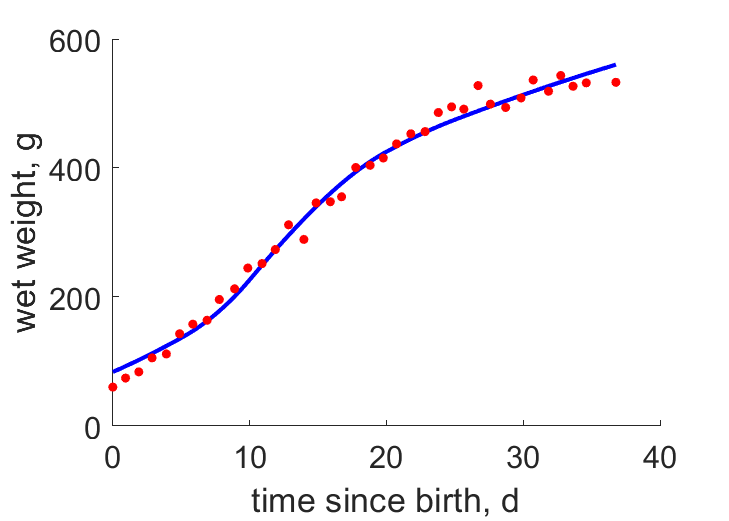Predictions & Data for this entry
| Model: std | climate: Cfb, Dfb, MA | migrate: Ml | phylum: |
| COMPLETE = 2.5 | ecozone: TH, TA, TP, MC | food: biCvf, biCii | class: |
| MRE = 0.036 | habitat: 0iFm, xiMc | gender: Dg | order: |
| SMSE = 0.002 | embryo: Tnsfm | reprod: O | family: |
Zero-variate data
| Data | Observed | Predicted | (RE) | Unit | Description | Reference |
|---|---|---|---|---|---|---|
| ab | 27.2 | 26.28 | (0.03395) | d | age at birth | BarlDowd2002 |
| tx | 37 | 36.99 | (0.0003728) | d | time since birth at fledging | BarlDowd2002 |
| tp | 111 | 124.1 | (0.1181) | d | time since birth at puberty | guess |
| tR | 1095 | 1095 | ( 0) | d | time since birth at 1st brood | AnAge |
| am | 1.095e+04 | 1.097e+04 | (0.001769) | d | life span | AnAge |
| Wwb | 60 | 63.93 | (0.06548) | g | wet weight at birth | BarlDowd2002 |
| Wwi | 644 | 620.4 | (0.0367) | g | ultimate wet weight | AnAge |
| Ri | 0.005479 | 0.005658 | (0.03252) | #/d | maximum reprod rate | BarlDowd2002 |
Uni- and bivariate data
| Data | Figure | Independent variable | Dependent variable | (RE) | Reference |
|---|---|---|---|---|---|
| tW |  | time since birth | wet weight | (0.03661) | BarlDowd2002 |
Pseudo-data at Tref = 20°C
| Data | Generalised animal | Hydroprogne caspia | Unit | Description |
|---|---|---|---|---|
| v | 0.02 | 0.05623 | cm/d | energy conductance |
| p_M | 18 | 404.2 | J/d.cm^3 | vol-spec som maint |
| k_J | 0.002 | 0.01687 | 1/d | maturity maint rate coefficient |
| k | 0.3 | 0.3005 | - | maintenance ratio |
| kap | 0.8 | 0.8423 | - | allocation fraction to soma |
| kap_G | 0.8 | 0.8136 | - | growth efficiency |
| kap_R | 0.95 | 0.95 | - | reproduction efficiency |
Discussion
- Body temperature is guessed
- mod_1: Pseudo-data point k is used, rather than k_J; Data set tp and parameter t_R are added, the latter replacing clutch interval t_N. Postnatal T is based on PrinPres1991, see get_T_Aves. See further the revision page, theme puberty
Bibliography